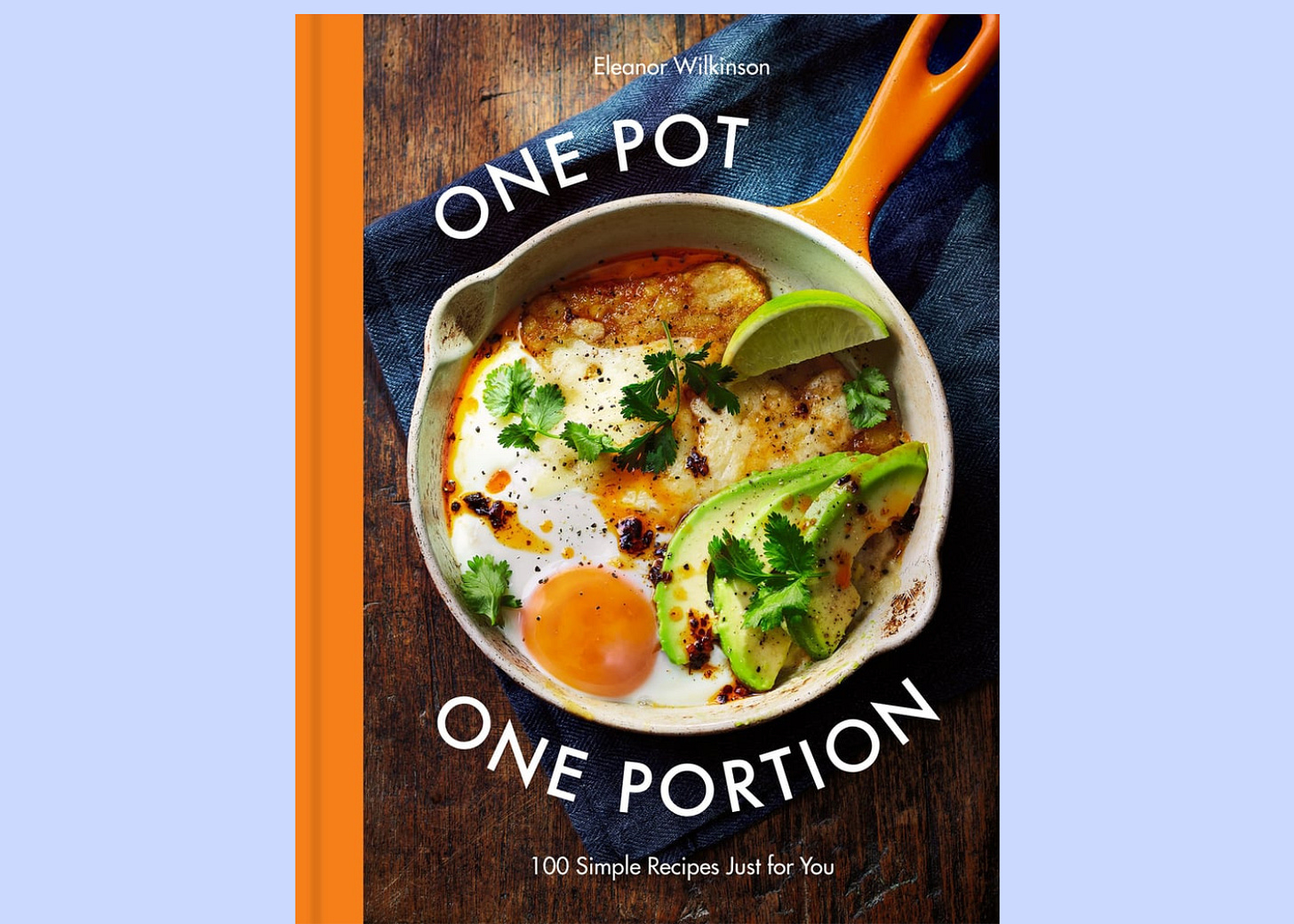As of 2024 the U.S. had about 38 million single-person households. When you live alone, being responsible for both making your meals and cleaning up your mess can discourage even the most homemade-loving cook. So the aim of One Pot One Portion—to take the stress out of solo cooking—holds real appeal. And for the most part, Eleanor Wilkinson succeeds.
“For me, cooking for one is all about joy,” Wilkinson writes. “The joy of choosing what you fancy, the joy of taking the time to make something only you need to find delicious and the joy of eating alone, finding a moment for yourself and your food.”
By restricting each recipe to cooking in one vessel, Wilkinson also restrains her ingredient lists, keeping a sense of ease and joy while fitting in vegetables, carbs, meat (sometimes), and seasonings. The recipes don’t aim to be groundbreakingly unusual (and are often frankly inauthentic versions of international recipes), but Wilkinson thoughtfully pulls flavor and texture from the few components. While many recipes are mildly seasoned—maybe too much so—she calls on ingredients that punch above their weight, such as chili crisp, jerk seasoning, preserved lemon, and masala curry paste.
So a baked dish mixes gnocchi, cherry tomatoes, an ear of corn, broccoli, masala curry, and cashews, topped with coconut yogurt and cilantro—11 ingredients, five or 10 minutes of chopping, and 20 minutes under the broiler. That’s on par for the effort most of her recipes demand. (Note, though, that some call for ingredients that may be a challenge to find at an average supermarket in the U.S., such as small amounts of fresh pasta.)
Chapter titles, somewhat arbitrarily, divide recipes by “comfort,” “fresh,” “simple,” “special,” and “sweet.” Comfort goes heavy on pasta, curries, and classics such as cottage pie and mac and cheese topped with fried onions. Fresh recipes lean into salads, including a fresh peach and burrata orzo salad sparked with cherry tomatoes, mint, and basil, perfect for steamy days that need a barely-on stove. Simple includes a green linguine that incorporates the creaminess of an egg and cheese with broccoli and spinach.
A zucchini “carpaccio” layers ricotta, thin slices of zucchini, lemon juice and zest, and olive oil-crisped capers, butter beans, and panko. Five main ingredients take the punch of pancetta and silkiness of egg yolk and butter to create a rich bowl of risotto carbonara. Creamy scrambled eggs fold in tangy cottage cheese; take Wilkinson up on her suggestion to top these with chili crisp and scallion.
A straightforward sheet-pan supper of sausages and potatoes gets a lift from cherry tomatoes, red bell pepper, and leeks turned in a marmalade-mustard mix; an orzo dish of bell peppers, cherry tomatoes, green olives, basil, and preserved lemon pulls together these strong flavors nicely with a drizzle of balsamic vinegar and olive oil.
A puff pastry croque madame proved less successful; the pastry is coated with a cream cheese and Dijon mixture, topped with ham, and sprinkled with Cheddar, with—supposedly—a small gap left for the egg to nestle. But the gap proved elusive, and the egg ran off the tart; the time required to cook the egg overcooked the cheese.
And a gyoza stir-fry requires an especially deft touch to toss and cook the the broccoli, pepper, and onion adequately without overcooking and breaking up the already-cooked gyoza in the pan. Nevertheless, this is a simple, filling dish with an appreciated sprinkling of chopped peanuts; many dishes have garnishes that make a big difference in the final flavor.
Wilkinson’s “special” chapter at first glance doesn’t seem much different from recipes in other chapters, but they may take a bit more time or splurging on ingredients. A straightforward mortadella and mozzarella sandwich goes up a notch with a one-portion homemade focaccia. Lobster spaghetti calls for two lobster tails, with lemon, tomatoes, cream, basil, and Parmesan. Salami and hot honey frying pan pizza uses homemade dough, while pork and kimchi steamed buns make the buns from scratch.
Sweets include puddings, a spoonable chocolate brownie, a skillet chocolate chip cookie, and several parfaits. A single cinnamon bun comes together in just a few minutes from a strip of puff pastry coated with butter, sugar, and cinnamon, braided and tucked into a ramekin or muffin cup.
Wilkinson suggests a few sizes of cooking vessels, though more specificity here would have been helpful. While she advises getting a small cast-iron skillet or two of 6.5 to 8 inches and a small pie dish, she offers no sizes for other items such as a saucepan or baking dish. The photo accompanying her sheet-pan marmalade sausage offers no clues to whether this is a regular half-sheet pan or (presumably) a quarter-sheet—potentially making a dramatic difference in results.
Wilkinson does try to help solo cooks avoid waste, by noting with each recipe another recipe that will use up a leftover ingredient—so if she calls for an egg yolk, she points you to a use for one egg white. She also structures her index by ingredient, to help with using up leftovers.
That seems especially important for ingredients such as puff pastry, when so little of a box may be used per recipe, but is difficult to divide while frozen and then can’t be refrozen. This takes readers only so far, though; after you’ve used 3 ounces of your fennel bulb, there are no other options for the rest in the index.
Of course, most solo cooks are not solo all the time, and the U.S. has 45 million two-person households. Happily for all of them, most of these recipes should double easily, either using a bigger pan or keeping the ingredients divided between individual dishes.
Quick takes:
One Pot, One Portion: 100 Simple Recipes Just for You, by Eleanor Wilkinson. 223 pages. Published by Clarkson Potter, 2025.
Organization: Chapter titles are Comfort, Fresh, Simple, Special, and Sweet; it was hard to tell what the difference is for the “simple” chapter, as many of the recipes are no quicker than in other chapters nor have shorter ingredient lists.
Ingredients measurement methods: A mix of ounces, cups, grams, and milliliters, all in one recipe—though frustratingly sometimes ingredients have no weight given, even an approximate one (such as just “2 pork sausages.”)
Photos: Every recipe has an accompanying, straightforward photo that nevertheless makes the point of plating food attractively even when it’s “for just myself.”
Index: Structured only by ingredient, excluding recipe titles.
Disclosure: I am an affiliate of Bookshop.org, which supports independent booksellers, and I will earn a commission if you click through and make a purchase on the title above.
The Spice of Life
Everything is better with Pepper
She may be happily single, but don’t even think about leaving Pepper home alone.



